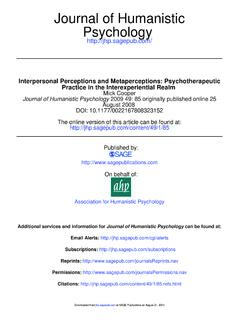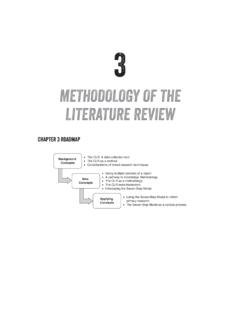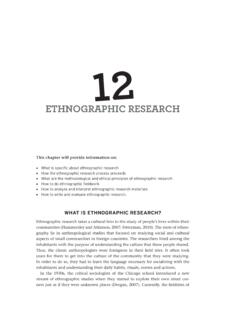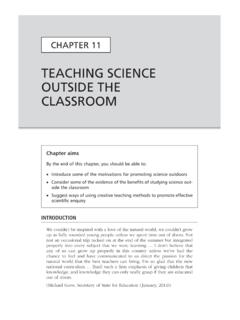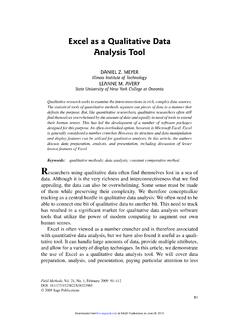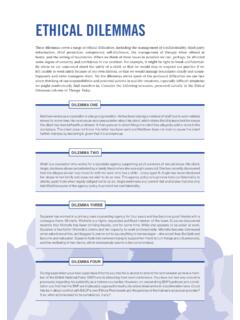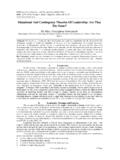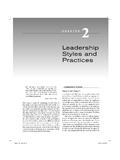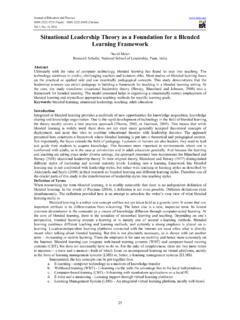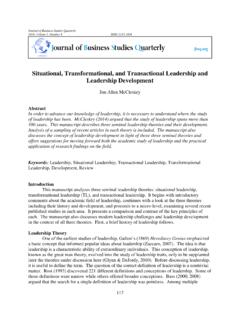Transcription of Contingency Theories of Leadership
1 Contingency Theories of LeadershipWhat makes Leadership effective in a group or organization? Scholars have been preoccupied with addressingthis key question perhaps since the inception of Leadership as a formal field of scientific inquiry. One classicapproach that gained prominence during the 1970s and 1980s is Contingency Theories of Theories hold that Leadership effectiveness is related to the interplay of a leader's traits orbehaviors and situational and BackgroundThe Contingency approach to Leadership was influenced by two earlier research programs endeavoring topinpoint effective Leadership behavior.
2 During the 1950s, researchers at Ohio State University administeredextensive questionnaires measuring a range of possible leader behaviors in various organizational multiple sets of Leadership behaviors were originally identified based on these questionnaires, twotypes of behaviors proved to be especially typical of effective leaders: (1) consideration, leader behaviors thatinclude building good rapport and interpersonal relationships and showing support and concern for subordinatesand (2) initiating structure, leader behaviors that provided structure ( , role assignment, planning,scheduling)
3 To ensure task completion and goal the same time, investigators from the University of Michigan's Survey Research Center conductedinterviews and distributed questionnaires in organizations and collected measures of group productivity toassess effective Leadership behaviors. The Leadership behavior categories that emerged from the University ofMichigan were similar to the consideration and initiating structure behaviors identified by the Ohio State University of Michigan investigators, however, termed these Leadership behaviors relation-oriented behaviorand task-oriented behavior.
4 This line of research was later extended by Robert Blake and Jane Mouton in 1964to suggest that effective leaders score high on both of these behaviors (high high leaders).Although research consistently supported the dichotomy between task and relations Leadership behavior, littleevidence suggested that these Leadership behaviors were related to increased Leadership effectiveness in groupperformance. Inconsistent findings characterized the bulk of research in this area, and soon the focus ofattention on Leadership behaviors as direct predictors of Leadership effectiveness shifted.
5 However, researchersdid not abandon the task versus relations dichotomy altogether. Instead, an alternative approach wasdeveloped that emphasized the potentially critical role of the situational context in linking Leadership behaviorsor traits to effective outcomes. This alternate approach became known as the Contingency Theories Contingency ApproachThe Contingency Theory of Leadership EffectivenessIn the 1960s, Fred Fielder advanced the first theory using the Contingency approach, the Contingency theory ofeffectiveness. The main idea of this early theory is that Leadership effectiveness (in terms of groupperformance) depends on the interaction of two factors: the leader's task or relations motivations and aspectsof the situation.
6 The leader's task or relations motivation is measured through the Least Preferred Coworker1scale (LPC). This scale asks leaders to recall a coworker (previously or currently) they work with least well andto characterize this individual with ratings on a series of 8-point bipolar adjectives ( , distant cold). HighLPC scores reflect more positive descriptions of the least preferred coworker, whereas low LPC scores evidencemore negative perceptions. Fielder argued that an individual with a high LPC score is motivated to maintainharmonious interpersonal relationships, whereas an individual with a low LPC score is motivated to focus on interpretation of exactly what high and low LPC scores mean has been the subject of much controversy anddebate.
7 For example, Robert Rice suggested that scores on the LPC represent values and attitudes, whereasother scholars have drawn linkages between high and low LPCs and task versus relations Leadership contended that task and relations motivations are stable traits that are not easily amenable to , attempts to encourage a high or low LPC leader to adapt to changing situations would be difficult, ifnot altogether futile. To optimize the possibility of an effective group outcome, this model advocates matching ahigh or low LPC leader to the right type of model purports that task or relations motivations are contingent on whether the leader can control andpredict the group's outcome ( , situational favorability).
8 situational favorability depends on threeassessments: (1) whether the leader perceives cooperative relations with subordinates (leader-memberrelations), (2) whether the task is highly structured with standardized procedures and measures of adequateperformance (task structure), and (3) whether the leader's level of authority is punishing or rewarding groupmembers (position power). The combination of leader-member relations, task structure, and position powercreates eight different situational types, known as octants 1 8, that have been more broadly categorized asfavorable situations, intermediate situations, and unfavorable situations.
9 Each different situational type is most effectively handled by either a high or low LPC leader. Specifically, high LPC leaders are most effective ininfluencing group performance in intermediate situations, and low LPC leaders are most effective in favorable orunfavorable 's Contingency model has been used in training programs and has received a lion's share of researchattention. A large number of studies and three meta-analyses more or less support the model 's , almost half a century after its introduction, further clarifications and future studies may be warrantedto iron out both theoretical and methodological issues associated with the model .
10 Nevertheless, many scholarsconsider the work by Fielder and his colleagues a classic contribution that inspired consideration of person andsituational aspects in Goal TheoryPath goal theory was originally developed by Martin Evans in 1970 and expanded by Robert House in 1971 intoa more complex Contingency theory. Drawing on expectancy theory and the Ohio and Michigan leader behaviorstudies, House suggested that a leader should help elucidate the path for followers to achieve group goals. Thisinvolves the leader employing particular behaviors in specific situations to increase follower satisfaction andmotivate efforts toward task accomplishment.

